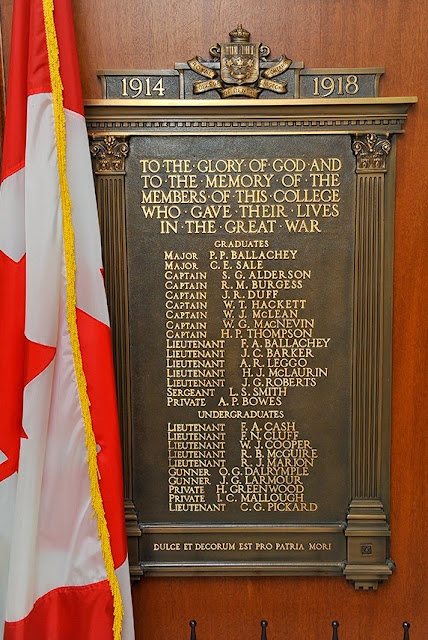 |
| Figure 1: War Memorial at the Faculty of Dentistry, University of Toronto. |
Although dentists were active as part of medical services before 1915, and provided dental care in the South African War (1899-1902), it was not until 1915 that Canadian Army Dental Corps (CADC) was organized. Its members served in the Great War of 1914-19, where "they cared for all dental matters affecting the personnel of the
Overseas Military Forces of Canada" (1). The first military dental clinic
in Canada was opened in March 1915 at the Canadian National Exhibition grounds
in Toronto (2). The first Director was Colonel J. Alex Armstrong, an Ottawa
dentist. The list of members grew to over 100 in 1915 to meet the overwhelming
demands of the war. The Canadian Government supplied dental instruments and materials, the Canadian Dental Association appointed a committee to collect funds for operating coats, operating gowns, laboratory aprons, towels, wipes, dusters, sponges, special dental surgical instruments, x-ray photographs, equipment for splints, books and many other necessities... (3). Member of the committee included Dr. Albert Webster and Dr. Seccombe (3), both former deans of the school.
Clinics were established overseas in England, where they performed
examinations and treatment of soldiers, including injuries to the nose and chin,
facial surgery and restoration (2).
 |
| Figure 2: Dean A. Webster |
After the war, the services disbanded and the new Canadian Army
Dental Services was formed with fewer officers appointed. Many other
administrative and organizational changes happened until the start of the
Second World War in 1939, when the Royal Canadian Dental Corps (RCDC) was re-established
and called out to service. Today the RCDC continues to operate as a personnel branch of the Canadian Armed Forces.
The Canadian Dental Association (CDA) has put together a detailed online display celebrating the
Centennial. The Canadian War Museum also has an exhibit entitled Oral
History: A Century of Canadian Military Dentistry, running from May 12,
2015 to November 15, 2015.
Impact on Dental Research
Impact on Dental Research
 |
| Figure 3: Dr. H. K. Box, PhD |
 |
| Figure 4: Dean W. Seccombe |
Bibliography
- Jackson, H. M. The Story of the Royal Canadian DentalCorps. 1956.
- Gullett, D. W. A History of Dentistry in Canada. [Toronto]: Published for the Canadian Dental Association, by University of Toronto Press, 1971.
- Webster, A.E. Army Dental Fund of the Canadian Dental Association. Dominion Dental Journal 27 (6): 235-6.
- Canadian Dental Association (2002). A century of service: dental technology and research: Part eight of a series. Accessed from https://www.cda-adc.ca/_files/about/about_cda/history/HSPart8.pdf
Figure 1: War Memorial set up by the Dental Museum at the Faculty of Dentistry, University of Toronto. Photo Courtesy of Jeff Comber, Senior Photographer, Faculty of Dentistry
Figure 2: Portrait of Dr. Albert Edward Webster (Dean, 1915-1923). Photo Courtesy of Jeff Comber, Senior Photographer, Faculty of Dentistry
Figure 3: Portrait of Dr. Harold Keith Box. Courtesy of James Fiege, IITS Manager, Faculty of Dentistry.
Figure 4: Portrait of Dr. Wallace Seccombe (Dean, 1923-1936). Photo Courtesy of Jeff Comber, Senior Photographer, Faculty of Dentistry.

No comments:
Post a Comment